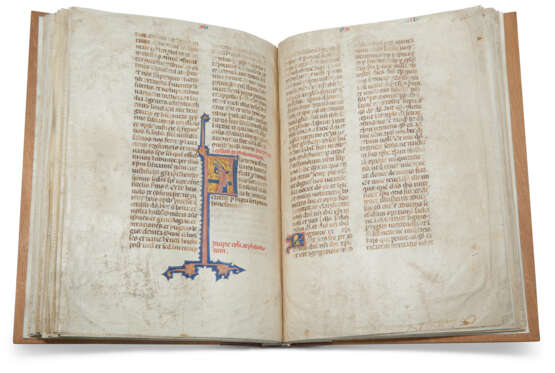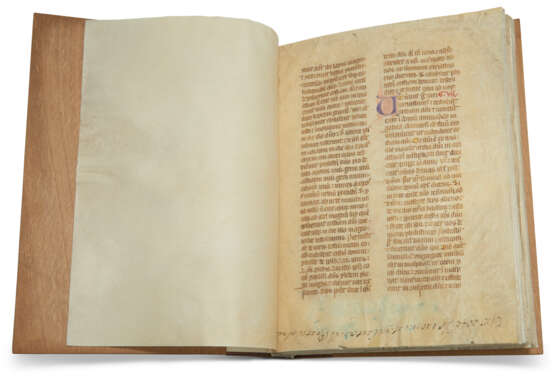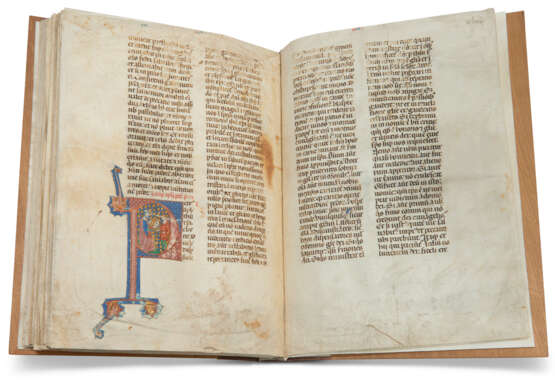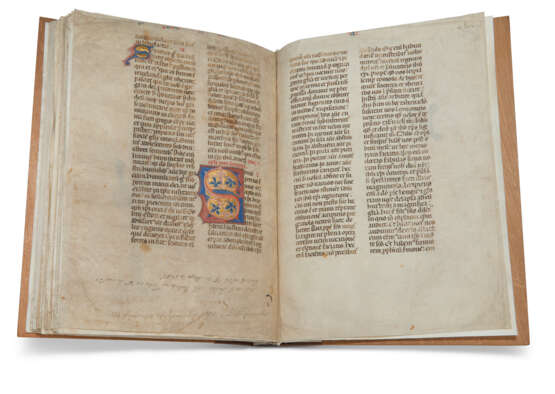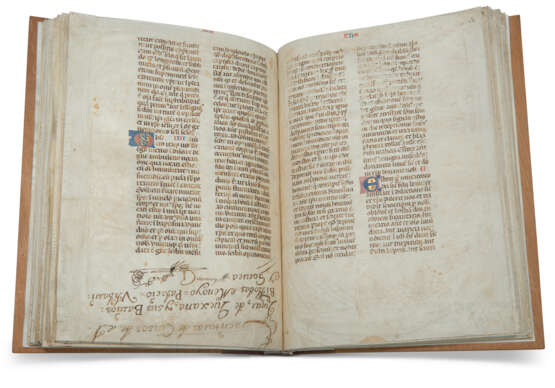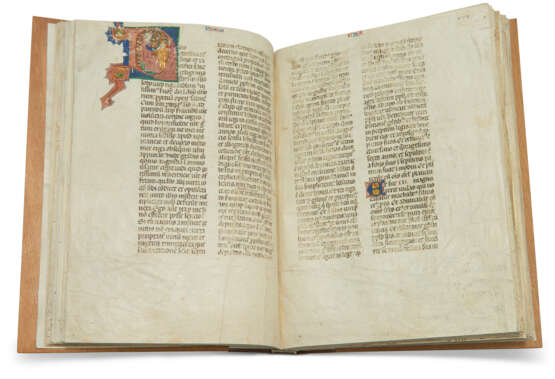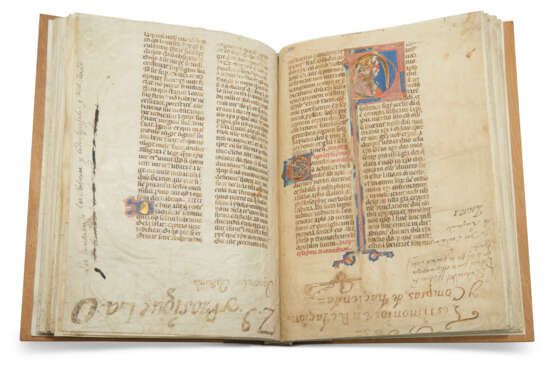ID 1214862
Lot 19 | The Quejana Bible
Valeur estimée
£ 30 000 – 50 000
Bible, in Latin, illuminated manuscript on vellum [Northern Spain, Basque Country, late 13th or early 14th century]
Handsome relics of a spectacular monastic lectern Bible; a rare survival from the Basque Country.
370 × 260mm. 68 leaves (34 bifolia), paginated (used here), written mostly in two columns of 33 lines, ruled space: 250 × 160mm, in more than one fine gothic hand, illuminated chapter initials throughout, larger initials to prologues, 5 very large historiated initials (some leaves in remarkably fine condition but others in poor condition due to having been recovered from use as wrappers and pouches for monastic property documents; see Provenance: all with creases, some very stained and rubbed, much of the illumination rubbed, many leaves with large marginal inscriptions). Rebound in biblical order in pale oak boards with blind-tooled leather spine by Ruth Kirkby, London, in 1996.
Provenance:
(1) Probably made for the monastery of San Juan Bautista, Quejana (in Álava province, south-west of Bilbao), and certainly dismembered there before the end of the 17th century: marginal inscriptions include dates from 1698 (p.12) to 1848, several mention ‘Quexana’, and at least one refers to ‘[...] este convento de San Juan de Quejana’. Two other groups of bifolia from the same bible with historiated initials were sold at Christie's, 13 July 2016, lots 103-105, and 8 December 2017, lots 10-12; two of these are described in Kidd, 2019, no 8, citing the present leaves throughout.
(2) Apparently salvaged in the 19th or 20th century by an antiquarian who added textual identifications in Spanish in blue pencil in some margins.
(3) Sold at Sotheby’s, 18 June 1996, lot 59, with full-page plate; bought by Sam Fogg on behalf of:
(4) The Schøyen Collection, MS 2197.
Content:
The bifolia contain 1 Kings 6:14–8:4 (pp.1–2), 14:32–15:8 (pp.3–4); 2 Chronicles 25:10–26:9 (pp.5–6), 34:21–35:11 (pp.7–8); Wisdom 16:2–18:13 (pp.9–12); Jeremiah 37:9–38:16 (pp. 13–14); and so on, with parts of the books of Ezekiel, Daniel, Malachi, 1 Maccabees, Matthew, John, Romans, 1 Corinthians, Galatians, Ephesians, 1–2 Thessalonians, 1 Timothy, Titus, Philemon, Hebrews, Acts, James, and 1–2 Peter.
A bible written on such a grand scale is far too large and heavy to be easily portable: it was presumably kept permanently on a lectern in the choir or refectory of a monastery for readings of the Divine Office and during meals. Due to their huge size, such lectern Bibles were typically bound in two, three, or even four volumes. Some of the known leaves have no foliation, others have one of at least two sets of medieval foliation, which suggest that they were bound as a set of at least three volumes, but the situation is complicated by the fact that the leaves from Kings (pp.1-4), which would have been in the first volume, have script and initials different from the rest, and are written with 32 lines per column; the leaves from Chronicles (pp.5–8), have 28 lines per column in a smaller rules space; the leaves from Wisdom (pp.9-12) onwards have 33 lines per column in a still smaller ruled space. The foliation of the New Testament books reaches ‘cclxxx’, so the complete volume doubtless comprised about 400 leaves.
Illumination:
The leaves include, as chance survivals, five large historiated and foliate initials, each at least 9 lines high:
(p.32) Prologue to Maccabees: A scholar-monk (he wears academic garb and has a tonsure) writing a small book, against a diaper ground
(p.79) 1 Corinthians: St Paul dictating his epistle, to a scribe at a writing-desk
(p.106) Prologue to Philemon: A dancing woman
(p.132) 1 Peter; St Paul, sitting at a writing-desk, handing his epistle (in the form of a booklet with lozenge decoration on the outer cover) to a young messenger
(p.134) 2 Peter: A large initial ‘S’, formed of a dragon’s body, with foliage for its head and the end of its tail
Large-scale high-quality Spanish illumination is very rare on the market.
Literature
Kidd, P., The McCarthy Collection, II, 2019, no 8.
| Lieu d'origine: | Europe, Espagne |
|---|---|
| Catégorie maison de vente aux enchères: | Manuscrits médiévaux et de la Renaissance, Livres et manuscrits |
| Lieu d'origine: | Europe, Espagne |
|---|---|
| Catégorie maison de vente aux enchères: | Manuscrits médiévaux et de la Renaissance, Livres et manuscrits |
| Adresse de l'enchère |
CHRISTIE'S 8 King Street, St. James's SW1Y 6QT London Royaume-Uni | |
|---|---|---|
| Aperçu |
| |
| Téléphone | +44 (0)20 7839 9060 | |
| Commission | see on Website | |
| Conditions d'utilisation | Conditions d'utilisation |
